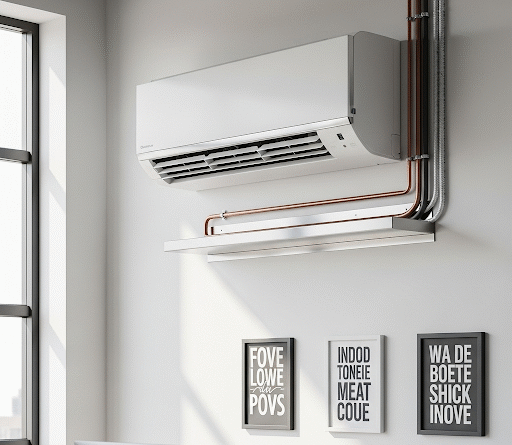A Complete Guide to the Benefits of Installing a High-Efficiency FCU Unit
The installation of a high-efficiency FCU Unit is a significant choice which could help to increase the effectiveness of the climate control system and conserve energy. This unit is not only necessary in today’s HVAC systems but also offers thermal control and the highest quality of indoor air with lower operational expenses than older models. They also suit a great deal of commercial and residential use as they are small and silent. The Fan Coil Unit, or fcu unit, is an effective air circulation unit that uses conditioned air to minimise the impact of the environment. Thus, the ultimate savings from a lower energy consumption rate and improved occupant comfort are greater in the long term than the investment.
The Top Benefits of Installing a High-Efficiency FCU Unit
The benefits of installing a modern and high-efficiency Fan Coil Unit (FCU) are numerous for managing the indoor environment of a building. These units use enhanced engineering to offer tangible improvement to older systems. The following are the top benefits:
- Energy Savings and Lower Operating Bills: The advantage of a modernised FCU is its energy efficiency. In modern units, Electronically Commutated (EC) fan motors and speed controls are frequently applied. Compared to old motors that operate at a single constant speed, EC fans can adjust their speed to meet actual heating or cooling requirements. This working procedure drastically reduces power use. Since all the energy is utilised where it is required, not where it is wasted in conditioning empty or already occupied rooms, the savings in the running costs are directly reflected in the large amounts of money saved in the long run of the system, which will be attractive to the bottom-line-oriented owners and property managers.
- Precise and Personalised Zonal Climate Control: FCUs of high efficiency offer localised temperature control, also known as zonal control. The units can be controlled separately with their individual thermostats. Moreover, all this implies that occupants of a single room/zone can choose heating and those in the next zone can choose cooling, all at the same time. Such a level of customisation eliminates the hot or cold spots that are characteristic of less flexible central systems. The capacity to accurately control the temperature of specific areas not only increases personal comfort but also conserves energy in parts where it is not needed.
- Enhanced Indoor Air Quality and Filtration: Circulation and filtration of air are major roles of these units. The high-performance FCUs are fitted with high-quality filters, occasionally with the choice of specialised electrostatic or fine-particulate media. The devices are tailored to filter outside sources of dust, pollen, and other air contaminants constantly, thus making it easier to clean and maintain a healthy indoor environment. Offsetting the above, their design features, such as insulated condensate trays, are made to impede the condensation of water, which is the main element leading to the formation of mould in the old HVAC parts.
- Exceptionally Quiet Performance: One aspect that plays an important role in the comfort of occupants is noise pollution, especially in places such as hotels and residential buildings. Advanced acoustic considerations are created in the units. The EC motors, combined with a variable fan speed control and consideration of the cabinet design, enable these systems to operate at much lower sound levels compared to previous generations. However, the system can be used to keep the environment cosy without generating a disturbing background buzz that causes poor focus in the workplace and worse quality sleep at home.
- Integration with Sustainable Systems: The contemporary FCUs are compatible with the environmentally conscious building infrastructure due to their design. They normally operate on water as the medium of heat transfer, which is easier to manage and check than refrigerant-based systems and does not require complicated F-Gas laws. Notably, they can be operated efficiently with both low temperatures of chilled water and lower temperatures of hot water from sources like air-source and ground-source heat pumps. The compatibility of a building enables it to exploit renewable energy technology in heating and cooling processes effectively.
- Easy and Versatile Installation: High-efficiency FCUs are designed for installation in various types of buildings, both new and existing, in a flexible manner. They are modular and small in size, which makes them easy to fit in ceilings, walls, or floor cavities. This also makes the process of building or refurbishing much easier since they merely need water piping as well as an electrical connection, which reduces the number of ductworks required. Moreover, this minimises the use of large air ducts, saving material and construction time. It is a viable option where retrofitting is needed in older buildings with limited space.
- Simplified Maintenance and Greater Reliability: The modern FCU components, like filters and coils, are usually readily available for inspection and cleaning within a short time. Moreover, the fact that each unit is independent means that a maintenance/service on a particular unit will not interfere with the climate control of the whole building. The localised nature of this implies that regular changes in filters and coil clean-ups are easy tasks to do, and when carried out regularly. That ensures the system operates at the optimum level and prevents unforeseen failures, leading to high long-term reliability.
- Quick Response to Temperature Changes: FCUs are to be very sensitive to variations in the thermal load of a room. Since they pump room air back through a water-filled coil, they can add or subtract heating or cooling power directly into the zone. When the user changes the thermostat, the unit quickly selects the new set point and adjusts the speed of its fan and water flow to achieve it within a couple of minutes. It is crucial in ensuring a constant thermal comfort throughout the day, particularly in areas experiencing varying occupancy levels.
- Lower Initial System Capacity Requirements: With its ability to provide a good deal of zonal control and being very efficient at the point of use, the central chiller and boiler plants at the building can typically be smaller than they would be with a less efficient traditional air system. The high-efficiency units have localised authority over the intense lifting all that means the central equipment does not require excessive compensation. However, this decrease in the minimum capacity of the main plant is reflected in the low initial investment in massive, expensive equipment, which provides significant savings to the project at the start-up.
Final Words
To sum up, these new systems have better climate control and tend to improve indoor air quality due to increased filtration. In addition to the direct monetary gains, selecting an effective model will be considered an environmental responsibility because the total carbon footprint of the building is minimised. A highly efficient air con fan coil unit can save a lot of operational costs in any climatic control unit. The improved occupant comfort and long-term savings resulting from the upgrade render it a feasible and effective choice for any property.

